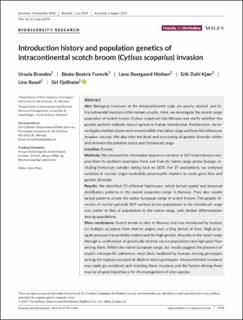| dc.contributor.author | Brandes, Ursula | |
| dc.contributor.author | Furevik, Beate Beatriz | |
| dc.contributor.author | Nielsen, Lene Rostgaard | |
| dc.contributor.author | Kjær, Erik Dahl | |
| dc.contributor.author | Rosef, Line | |
| dc.contributor.author | Fjellheim, Siri | |
| dc.date.accessioned | 2020-11-26T13:46:03Z | |
| dc.date.available | 2020-11-26T13:46:03Z | |
| dc.date.created | 2019-09-24T15:56:26Z | |
| dc.date.issued | 2019 | |
| dc.identifier.citation | Diversity and Distributions: A journal of biological invasions and biodiversity. 2019, 25 1773-1786. | en_US |
| dc.identifier.issn | 1366-9516 | |
| dc.identifier.uri | https://hdl.handle.net/11250/2689822 | |
| dc.description.abstract | Abstract Aim: Biological invasions at the intracontinental scale are poorly studied, and intracontinental invasions often remain cryptic. Here, we investigate the recent range expansion of scotch broom (Cytisus scoparius) into Norway and clarify whether the genetic patterns indicate natural spread or human introduction. Furthermore, we investigate whether plants were moved within the native range and how this influences invasion success. We also infer the level and structuring of genetic diversity within and between the putative native and introduced range. Location: Europe. Methods: We analysed the chloroplast sequence variation in 267 scotch broom samples from its northern expansion front and from its native range across Europe, including herbarium samples dating back to 1835. For 37 populations, we analysed variation in nuclear single‐nucleotide polymorphic markers to study gene flow and genetic diversity. Results: We identified 20 different haplotypes, which lacked spatial and temporal distribution patterns in the recent expansion range in Norway. They also mostly lacked patterns across the native European range of scotch broom. The genetic diversity of nuclear genomic SNP markers across populations in the introduced range was similar to that of populations in the native range, with limited differentiation among populations. Main conclusions: Scotch broom is alien to Norway and was introduced by humans on multiple occasions from diverse origins over a long period of time. High propagule pressure has probably maintained the high genetic diversity in the novel range through a combination of genetically diverse source populations and high gene flow among them. Within the native European range, our results suggest the presence of cryptic intraspecific admixture, most likely mediated by humans moving genotypes among the regions occupied by distinct native genotypes. Intracontinental invasions may easily go unnoticed and revealing these invasions and the factors driving them may be of great importance for the management of alien species. | en_US |
| dc.language.iso | eng | en_US |
| dc.rights | Navngivelse 4.0 Internasjonal | * |
| dc.rights.uri | http://creativecommons.org/licenses/by/4.0/deed.no | * |
| dc.title | Introduction history and population genetics of intracontinental scotch broom (Cytisus scoparius) invasion. | en_US |
| dc.type | Peer reviewed | en_US |
| dc.type | Journal article | en_US |
| dc.description.version | publishedVersion | en_US |
| dc.source.pagenumber | 1773-1786 | en_US |
| dc.source.volume | 25 | en_US |
| dc.source.journal | Diversity and Distributions: A journal of biological invasions and biodiversity | en_US |
| dc.identifier.doi | 10.1111/ddi.12979 | |
| dc.identifier.cristin | 1728496 | |
| dc.relation.project | NMBU - Norges miljø- og biovitenskapelige universitet: - | en_US |
| dc.relation.project | Norges forskningsråd: 213291 | en_US |
| cristin.unitcode | 192,10,2,0 | |
| cristin.unitname | Institutt for plantevitenskap | |
| cristin.ispublished | true | |
| cristin.fulltext | original | |
| cristin.qualitycode | 1 | |

